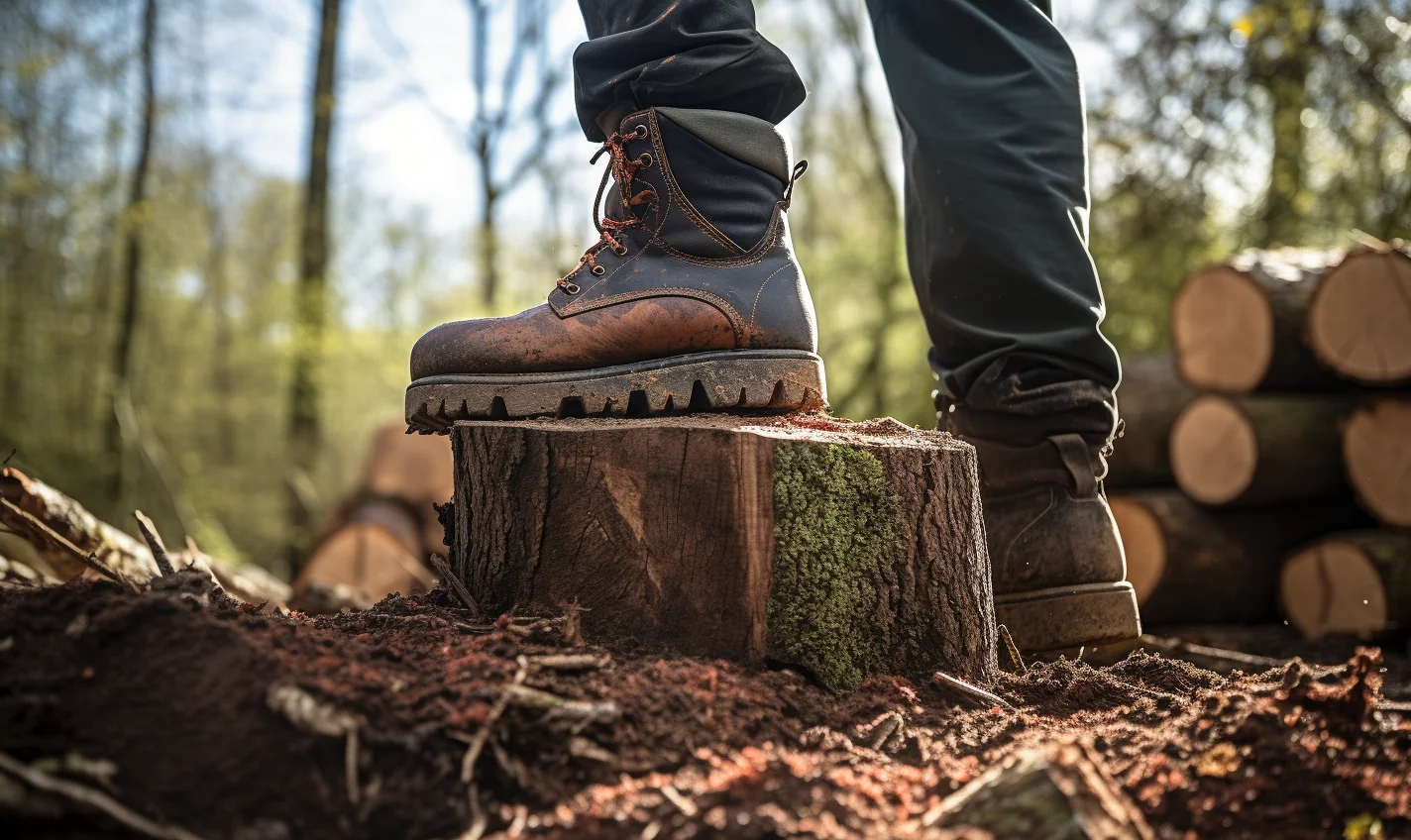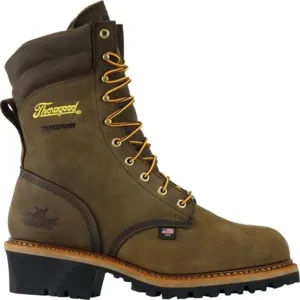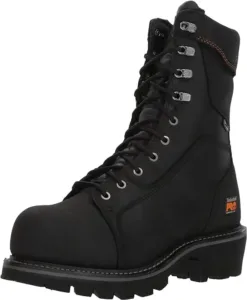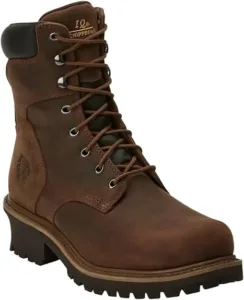
Logger Boots: From Timber to Trend
Logger boots, with their rugged exteriors and no-nonsense practicality, have transcended their forestry roots to become a symbol of durability and outdoor prowess. But what exactly makes these boots different from your average work boots, and why do they carry such a hefty price tag? Let’s delve into the history, construction, and appeal of these iconic boots.
Just looking for the top picks? These are the top 3 best men’s logger boots available for the working man today:
A Walk Through Time: The History of Logger Boots
The story of logger boots begins in the late 19th century, when the Pacific Northwest logging industry boomed. Lumberjacks needed footwear that could withstand the harsh realities of the forest: treacherous terrain, falling logs, and unpredictable weather. Early boots were often makeshift concoctions of leather scraps and nails, offering little protection and comfort.
The 20th century saw the evolution of logger boots into the form we recognize today. Leather became the preferred material for its sturdiness and breathability, steel toes were introduced for safety, and Vibram rubber outsoles provided superior traction on uneven surfaces. Brands like Danner and Chippewa emerged, specializing in boots built to endure the demands of logging.
Built to Withstand the Woods: What Makes Logger Boots Different
While regular work boots prioritize comfort and support, logger boots are all about protection and traction. Here’s what sets them apart:
- Tougher materials: Logger boots typically use thick, full-grain leather for superior durability and puncture resistance. Regular work boots may use thinner leather or synthetic materials.
- Steel or composite toes: These protect feet from falling logs and other hazards. Regular work boots may not have toe protection.
- Shanks: Steel or fiberglass shanks provide rigidity and support, essential for carrying heavy loads and traversing uneven terrain. Regular work boots may have shanks, but they may be made of less sturdy materials.
- Aggressive outsoles: Deep lugs on Vibram rubber outsoles offer excellent grip on mud, wet logs, and loose rocks. Regular work boots may have less aggressive outsoles.
- Higher ankle support: This stabilizes the ankle and protects it from sprains and twists. Regular work boots may have shorter ankle support.
Why the Price Tag Bites: The Cost of Quality
Quality materials, expert craftsmanship, and safety features come at a cost. Logger boots can range from $200 to $400, significantly more than regular work boots. However, the investment pays off in terms of durability, protection, and longevity. A well-maintained pair of logger boots can last for years, making them a cost-effective choice in the long run.
Beyond the Forest: The Modern Appeal of Logger Boots
The rugged charm and undeniable practicality of logger boots have extended their reach beyond the logging industry. They’ve become popular among outdoor enthusiasts, hikers, construction workers, and even fashionistas. Their durability, comfort, and timeless style make them a versatile choice for anyone who appreciates quality footwear.
Choosing the Right Logger Boots
If you’re considering investing in a pair of logger boots, consider these factors:
- Your needs: What will you be using them for? Heavy-duty logging requires different features than occasional hikes.
- Material: Full-grain leather is the gold standard, but oiled or waxed leather can offer additional weatherproofing.
- Toe protection: Steel toes offer maximum protection, while composite toes are lighter and non-metallic.
- Fit: Logger boots should be snug but not tight, allowing for thick socks.
With their rich history, rugged construction, and timeless appeal, logger boots are more than just footwear; they’re a symbol of resilience and the human spirit’s ability to conquer challenging environments. So, whether you’re tackling a forest or navigating the urban jungle, a good pair of logger boots can be your trusty companions.
Top Men’s Logger Boots Contenders for the Working Man:
1.The Thorogood Logger Series 9″ Waterproof Steel Toe Work Boots:
The Thorogood Logger Series 9″ Waterproof Steel Toe Work Boots are a popular choice for those seeking a durable and protective boot for demanding work environments. Here’s a breakdown of their key features and what sets them apart:
Built for Tough Jobs:
- Full-grain leather: Available in two leathers, Crazy Horse and Stud Horse, both known for their durability, water resistance, and ability to age gracefully.
- Steel toe: Meets ASTM standards for impact and compression, protecting your feet from falling objects or heavy loads.
- Steel shank: Provides additional rigidity and support for carrying heavy loads and traversing uneven terrain.
- Vibram outsole: Renowned for its grip and durability, the Vibram outsole offers excellent traction on various surfaces, including mud, wet logs, and loose rocks.
- Storm welt construction: This Goodyear welt construction method enhances the boot’s durability and allows for resoling, extending its lifespan.
Comfort and Protection:
- Waterproof membrane: Keeps your feet dry in wet conditions, essential for outdoor work or harsh environments.
- Removable Ultimate Shock Absorption™ footbed: Provides cushioning and support, reducing fatigue and stress on your feet throughout the workday.
- Electrical hazard (EH) rated: Protects against open circuits up to 18,000 volts under dry conditions.
- 9-inch height: Offers ankle support and protection from splashes or debris.
Additional Considerations:
- Weight: These boots are built for durability and may feel heavier than some work boots.
- Insulation: Some models offer optional 400g Thinsulate insulation for warmth in cold weather.
Overall, the Thorogood Logger Series 9″ Waterproof Steel Toe Work Boots are a solid choice for demanding work environments. Their combination of durability, protection, comfort, and waterproofness make them a worthwhile investment for those who prioritize quality footwear.
2. Timberland PRO Men’s Rip Saw Composite-Toe Logger Work Boot:
The Timberland PRO Men’s Rip Saw Composite-Toe Logger Work Boot is a durable and protective boot designed for demanding work environments, particularly in the logging industry. Here’s a breakdown of its key features:
Built for Tough Jobs:
- Premium full-grain leather: Provides excellent durability, water resistance, and breathability.
- Composite toe: Meets ASTM standards for impact and compression, protecting your feet from falling objects or heavy loads without the weight and cold conductivity of steel.
- Steel shank: Offers additional rigidity and support for carrying heavy loads and traversing uneven terrain.
- Vibram® outsole: Renowned for its grip and durability, the Vibram® outsole offers excellent traction on various surfaces, including mud, wet logs, and loose rocks.
- Goodyear welt construction: This construction method enhances the boot’s durability and allows for resoling, extending its lifespan.
Comfort and Protection:
- Waterproof membrane: Keeps your feet dry in wet conditions, essential for outdoor work or harsh environments.
- Removable Anti-Fatigue Technology™ footbed: Provides cushioning and shock absorption, reducing fatigue and stress on your feet throughout the workday.
- Electrical hazard (EH) rated: Protects against open circuits up to 18,000 volts under dry conditions.
- 9-inch height: Offers ankle support and protection from splashes or debris.
Additional Considerations:
- Weight: These boots are built for durability and may feel heavier than some work boots.
- Insulation: Some models offer optional 400g Thinsulate insulation for warmth in cold weather.
Overall, the Timberland PRO Men’s Rip Saw Composite-Toe Logger Work Boots are a well-respected option for those seeking a durable, protective, and comfortable boot for demanding work environments. Their combination of high-quality materials, construction, and features make them a worthwhile investment for those who prioritize quality footwear.
Interested in more in-depth reviews and guides like this? Check out these posts:



